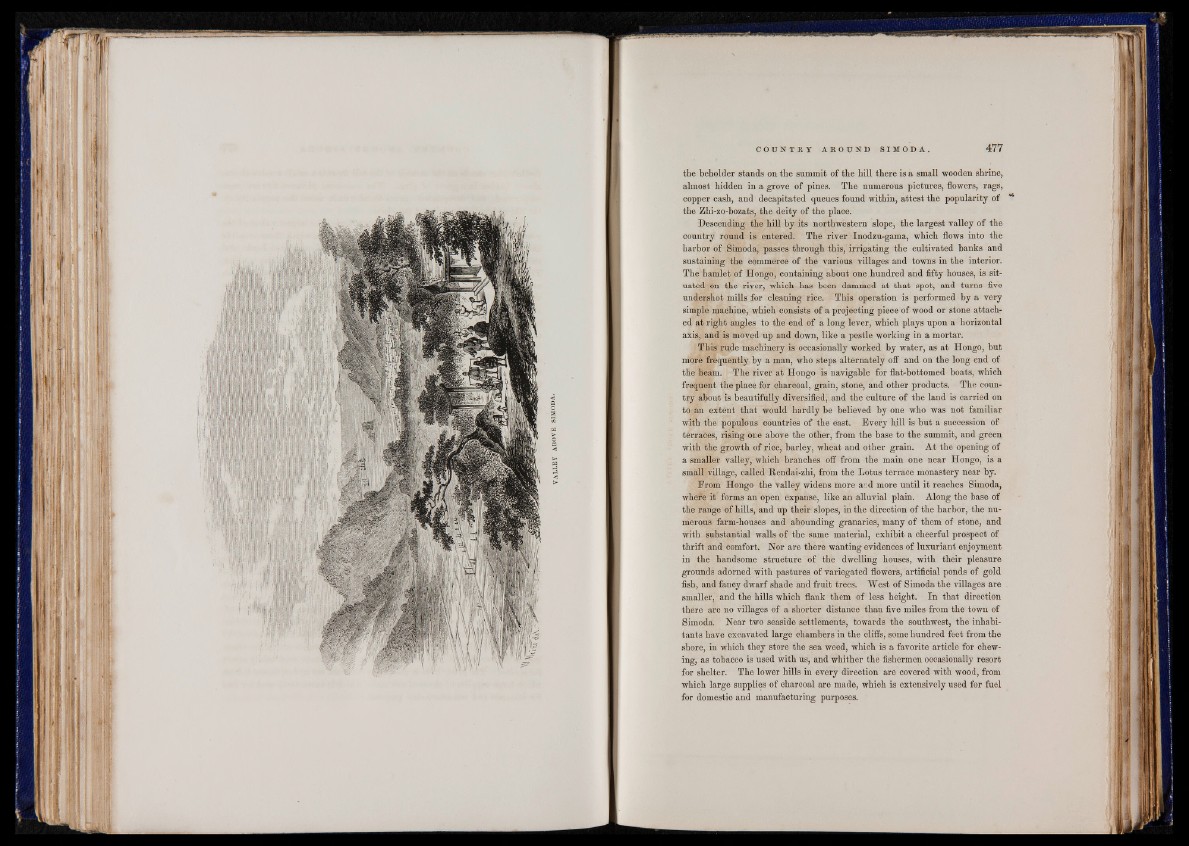
VALLEY ABOVE SIMODA.
C O U N T R Y A R O U N D S IMO D A . 477
the beholder stands on the summit of the hill there is a small wooden shrine,
almost hidden in a grove of pines. The numerous pictures, flowers, rags,
copper cash, and decapitated queues found within, attest the popularity of “
the Zhi-zo-bozats, the deity of the place.
Descending the hill by its northwestern slope, the largest valley of the
country round is entered. The river Inodzu-gama, which flows into the
harbor of Simoda, passes through this, irrigating the cultivated banks and
sustaining the commerce of the various villages and towns in the interior.
The hamlet of Hongo, containing about one hundred and fifty houses, is situated
on the river, which has been dammed at that spot, and turns five
undershot mills for cleaning rice. This operation is performed by a very
simple machine, which consists of a projecting piece of wood or stone attached
at right angles to the end of a long lever, which plays upon a horizontal
axis, and is moved up and down, like a pestle working in a mortar.
This rude machinery is occasionally worked by water, as at Hongo, but
more frequently by a man, who steps alternately off and on the long end of
the beam. The river at Hongo is navigable for flat-bottomed boats, which
frequent the place for charcoal, grain, stone, and other products. The country
about is beautifully diversified, and the culture of the land is carried on
to lan extent that would hardly be believed by one who was not familiar
with the populous countries of the east. Every hill is but a succession of
terraces, rising one above the other, from the base to the summit, and green
with the growth of rice, barley, wheat and other grain. At the opening of
a smaller valley, which branches off from the main one near Hongo, is a
small village, called Rcndai-zhi, from the Lotus terrace monastery near by.
From Hongo the valley widens more and more until it reaches Simoda,
where it forms an open expanse, like an alluvial plain. Along the base of
the range of hills, and up their slopes, in the direction of the harbor, the numerous
farm-houses and abounding granaries, many of them of stone, and
with substantial walls of the same material, exhibit a cheerful prospect of
thrift and comfort. Nor are there wanting evidences of luxuriant enjoyment
in the handsome structure of the dwelling houses, with their pleasure
grounds adorned with pastures of variegated flowers, artificial ponds of gold
fish, and fancy dwarf shade and fruit trees. West of Simoda the villages are .
smaller, and the hills which flank them of less height. In that direction
there are no villages of a shorter distance than five miles from the town of
Simoda. Near two seaside settlements, towards the southwest, the inhabitants
have excavated large chambers in the cliffs, some hundred feet from the
shore, in which they Btore the sea weed, which is a favorite article for chewing,
as tobacco is used with us, and whither the fishermen occasionally resort
for shelter. The lower hills in every direction are covered with wood, from
which large supplies of charcoal are made, whioh is extensively used for fuel
for domestic and manufacturing purposes.